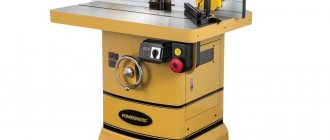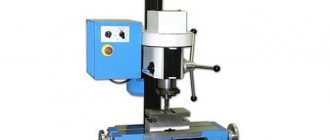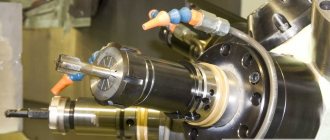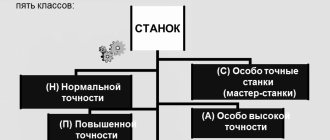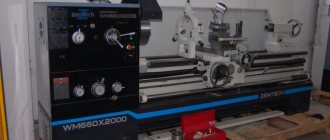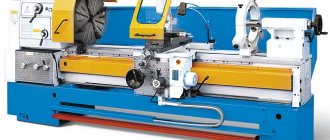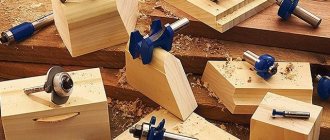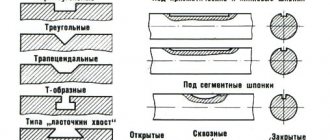Milling machines: general information, classification, designation
Milling machines are designed for processing external and internal flat, shaped surfaces, shoulders, grooves, straight and helical grooves, splines on shafts, cutting gears, etc.
The designs of milling machines are varied. In general, milling machines can be divided into two main groups:
- general purpose or universal milling machines (vertical milling, horizontal milling, longitudinal milling
- specialized and special milling machines (slot milling, key-milling, rotary milling, copy milling, etc.)
The main shaping movements of milling machines are the rotation of the cutter (the main movement) and the feed movement, which is imparted to the workpiece or cutter.
The main movement and feed drives are operated separately. Auxiliary movements associated with the supply and removal of the workpiece to the tool are mechanized and carried out by a drive of accelerated movements.
The main elements of machine mechanisms are unified.
The main parameter characterizing general-purpose milling machines is the size of the working surface of the table.
Based on their design features, these machines are divided into:
- console machines (the table is located on a lifting console bracket)
- non-cantilever machines (the table is moved on a fixed frame in the longitudinal and transverse directions)
- continuous machines (rotary and drum)
- a — universal console horizontal milling machine
- b - universal cantilever horizontal milling machine
- c — universal universal non-cantilever milling machine
- g — cantilever vertical milling machine
- d - non-cantilever vertical milling machine
- e - non-cantilever horizontal milling machine
- g - longitudinal milling machine
- h — rotary milling machine
- and - drum milling machine
Cantilever milling machines are most common in single, small- and medium-scale production of rice. 119, a, b, c, d). Horizontal and vertical cantilever milling machines are the most common type of machines used for milling work. Cantilever milling machines get their name from the cantilever bracket (console), which moves along the vertical guides of the machine bed and serves as a support for the horizontal movements of the table.
A universal cantilever milling machine (Fig. 119, a) has a horizontal spindle 2 and a retractable trunk 1, on which a shackle 3 is installed, supporting a mandrel with a cutter; the console 4 moves vertically along the guide of the rack 5. The console contains a slide 6 and a rotary table 7 .
Horizontal cantilever milling machines (Fig. 119, a) have a horizontally located spindle 2 that does not change its location. The table can move perpendicular to the spindle axis in the horizontal and vertical directions. Unlike the Universal console milling machine, the work table does not rotate around a vertical axis.
The wide-universal cantilever milling machine (Fig. 119; b, c) in addition to the horizontal spindle, has a spindle head 1, which can be rotated on the trunk in two mutually perpendicular directions, due to which the spindle with the cutter can be installed at any angle to the table plane and to the workpiece . An overhead head 2 is mounted on head 1, intended for drilling, reaming, countersinking, boring and milling.
A vertical cantilever milling machine (Fig. 119, d) has a vertical spindle 3, which is located in a rotating spindle head 2 mounted on a stand 1.
Cantilever-free vertical milling machines (Fig. 119, e), used for processing blanks of large parts, have a slide 2 and a table 3, which move along the guides of the frame 1. The spindle head 5 moves vertically along the guides of the rack 6. The spindle 4 has vertical axial movements when installing the cutter. The table moves only in the longitudinal and transverse directions.
Cantileverless horizontal milling machines (Fig. 119, e), used for processing blanks of large-sized parts, have a slide 2 and a table 3, which move along the guides of the frame 1. The spindle head 5 moves vertically along the guides of the rack 6. The spindle 4 has axial movements at installing the cutter.
Longitudinal milling machines (Fig. 119, g) are designed for processing blanks of large-sized parts. On the frame 1, two vertical posts 6 are installed, connected by a cross member 7. Milling heads 3 with horizontal spindles and a traverse (cross member) 4 are mounted on the guide posts. Milling heads 5 with vertical spindles are mounted on the latter. Table 2 moves along the guides of racks 4.
Rotary milling machines (Fig. 119, h), designed for processing surfaces with end mills, have one or more spindles 3 for finishing and roughing. The spindle head 2 moves along the guides of the rack 1. The table 4, rotating continuously, imparts feed rotation to the workpieces installed on it. The table with slide 5 has an installation movement along the guides of the frame 6.
Drum milling machines (Fig. 119, i) are used in large-scale and mass production. The workpieces are installed on a rotating drum 2, which has a feed movement. Milling heads 3 (for roughing) and 1 (for finishing) move along the guides of the racks 4.
Work tool
Cantilever and non-cantilever, conventional vertical milling or ultra-modern CNC machines cannot do without the main part - the cutting tool. It consists of a variety of cutters made from high-quality steel, which allows processing any metals and surfaces. Any type of processing tool is rigidly fixed in the spindle (mainly by a jaw chuck), which guarantees precision processing.
A brief list of possible processing planes and the cutting tools required for this is as follows:
- horizontal – end mills of various configurations;
- inclined - end and end;
- vertical surfaces and surfaces with ledges - end mills;
- milling of grooves of any configuration - end or single-angle cutters;
- machining of cylindrical gears – finger tool.
For milling complex surfaces that combine sections of various types (convex, straight or concave, with ledges or recesses), the use of modern cantilever milling units equipped with CNC has proven to be more effective. However, it is also possible to produce parts of this type on a conventional vertical milling machine, although it takes a little more time. To do this, it is necessary to draw up a special processing scheme for the workpiece and an equation for manufacturing a part of complex shape.
When developing an equation, the following parameters must be taken into account:
- roughness indicators of the resulting part;
- cutter radius;
- thickness of the processed material;
- amount of feed of the workpiece to the cutter;
- thickness of the removed chips (comb height);
- different axial angles of rotation of the tool.
The quality of processing, characterized by the amount of roughness, depends to the greatest extent on the angle of rotation of the cutter and the amount of feed of the workpiece. Other factors also have an impact, but much less.
High-precision vertical milling machines sold by our company allow us to minimize wasted time and reduce the amount of waste generated during milling of both individual parts and entire batches. This results in significant cost savings for the entire enterprise.
Cantilever milling machines
Cantilever milling machines are the most common type of machines used for milling work. Cantilever milling machines get their name from the cantilever bracket (console), which moves along the vertical guides of the machine bed and serves as a support for the horizontal movements of the table.
The presence of a console, while providing cantilever-milling machines with a number of conveniences during maintenance, somewhat reduces the rigidity at the junction with the frame, therefore, in the designs of modern machines, the length of the console guides has been significantly increased, devices have been created for securing the moving parts of the machine, and the rigidity of the body parts has been increased.
Since for the most part the parts used in mechanical engineering fit into the dimensions of general-purpose cantilever-milling machines, the fleet of milling machines in mechanical shops is mainly equipped with horizontal and vertical milling machines of the cantilever type, and the fleet of tool and mechanical repair shops, in addition, also universal-milling and wide-universal-milling.
In addition, modifications are produced based on some basic models. For example, on the basis of vertical milling machines 6M12P and 6M13P, high-speed console vertical milling machines 6M12G1B and 6M13PB are produced. Based on the 6M82G horizontal milling machine, a faster model of the 6M82GB machine is produced. On the basis of universal milling machines 6N81 and 6N82, wide-universal milling machines 6N81A and 6M82Sh are produced. Widely versatile milling machines are currently widely used in individual and small-scale production to perform a variety of milling, boring and drilling work. These machines can be used to produce metal models, die-forms, templates, cams, etc.
The highly versatile 6N81A machine has a spindle head located on the trunk and rotating around a horizontal axis from 0 to 115°. In a horizontal position of the head, the machine operates like a horizontal milling machine, and in a vertical position, like a vertical milling machine.
The highly versatile 6M82Sh machine and the larger 6M83Sh machine, similar in design, have two spindles: one is horizontal, like a conventional horizontal milling machine, the second is located on the trunk and can be installed at any desired angle. The use of a dividing head and a round rotary table significantly expands the range of applications of these machines. For processing various types of surfaces, as well as large-sized workpieces that exceed the table area in size, the vertical spindle head is mounted on a retractable trunk and can be rotated at any angle in two mutually perpendicular planes. In this case, simultaneous operation of horizontal and vertical spindles is possible
The standard sizes of cantilever milling machines are usually characterized by the size of the working (mounting) surface of the table. Cantilever milling machines can have a horizontal , universal (widely universal) and vertical design with the same size of the working surface of the table. The combination of different versions of the machine with the same basic dimensional characteristics of the table is called the dimensional range of machines .
In the USSR, the production of cantilever milling machines of five standard sizes was mastered: No. 0; No. 1; No. 2; No. 3 and No. 4 , and a full range of machines was produced for each size - horizontal, universal and vertical. Each machine of the same size range had the same designation in the code, corresponding to the size of the working surface of the table.
Depending on the size of the working surface of the table, the following sizes of cantilever milling machines are distinguished:
| Size | Range of machines | Table size, mm |
| 0 | 6Р10, 6Р80, 6Р80Г, 6Р80Ш | 200 x 800 |
| 1 | 6N11, 6N81, 6N81G; 6Р11, 6Р81, 6Р81Г, 6Р81Ш | 250 x 1000 |
| 2 | 6M12P, 6M82, 6M82G; 6Р12, 6Р82, 6Р82Ш; 6T12, 6T82, 6T82G, 6T82Sh | 320 x 1250 |
| 3 | 6M13P, 6M83, 6M83G; 6Р13, 6Р83; 6T13, 6T83, 6T83G | 400 x 1600 |
| 4 | 6M14P, 6M84, 6M84G | 500 x 2000 |
In accordance with the size of the table, the overall dimensions of the machine itself and its main components (bed, table, slide, console, trunk), the power of the electric motor and the magnitude of the greatest movement (stroke) of the table in the longitudinal direction, the slide in the transverse direction and the console in the vertical direction change.
General information
A vertical milling machine is a group of metal-cutting units that perform surface processing using a cutter part. VFS differ in many parameters, but in all of them the processing cutter is fixed in the installation in a vertical position. Vertical machines are mainly used for processing metals, but they can also be used to process other materials - wood, plastic, composite compounds.
A vertical milling machine allows you to process parts of any shape, size, size, and with its help you can perform all basic operations - cutting, drilling, removing the top layers of material. The main producing countries of VFS are Russia, Germany, Czech Republic, Japan, China. Engineering and technical capabilities depend on the design, and the average installation cost ranges from 100 to 500 thousand rubles. Models with numerical control (CNC) are several times more expensive - their price ranges from 350 thousand to 2 million rubles.
Cantilever milling machines produced in the USSR and CIS
| Series | Size | Manufacturer | Year | Model |
| 6 | 2 | SFFS | 1932 | 682 |
| 6B | 0 | |||
| 1 | ||||
| 2 | SFFS | 1937 | 6B12, 6B82, 6B82G | |
| 3 | ||||
| 6K | 0 | |||
| 1 | DZFS | 6K11, 6K81, 6K81G, 6K81SH | ||
| 2 | SFFS | 6K12, 6K82, 6K82G, 6K82SH | ||
| 3 | SFFS | 6K13P, 6K83, 6K83G, 6K83SH | ||
| 6H | 0 | Zalgiris | 1969 | 6N10, 6N80, 6N80G, 6N80Sh |
| 1 | DZFS | 1970 | 6N11, 6N81, 6N81G, 6N81A, 6N81D | |
| 2 | SFFS | 1951 | 6N12, 6N82, 6N82G | |
| 3 | GZFS, VSW | 1951 | 6N13, 6N13F3, 6N83, 6N83G, 6N13GA | |
| 6M | 0 | Zalgiris | 6M10, 6M80, 6M80G, 6M80Sh | |
| 1 | DZFS | 1971 | 6M11, 6M11K, 6M81, 6M81G, 6M81Sh, 6M81Sh-1, 6M81Sh-1F1, 6M81ShF2 | |
| 2 | SFFS | 1961 | 6M12P, 6M12PB, 6M82, 6M82G, 6M82GB, 6M82Sh | |
| 3 | SFFS | 1961 | 6M13P, 6M13PB, 6M83, 6M83G, 6M83Sh | |
| 6Р | 0 | Zalgiris | 1973 | 6Р10, 6Р80, 6Р80Г, 6Р80Ш |
| 1 | DZFS | 6Р11, 6Р11К, 6Р11Ф3, 6Р81, 6Р81Г, 6Р81Ш | ||
| 2 | SFFS | 1972 | 6Р12, 6Р12К, 6Р82, 6Р82Г, 6Р82Ш | |
| 3 | GZFS, VSW | 1972 | 6Р13, 6Р13Б, 6Р13Ф3, 6Р13Ф3-3, 6Р83, 6Р83Г, 6Р83Ш | |
| 6T | 0 | Zalgiris | 1986 | 6Т10, 6Т80, 6Т80Ш |
| 1 | ||||
| 2 | SFFS | 1985 | 6T12, 6T82, 6T82G, 6T82Sh | |
| 3 | SFFS | 1985 | 6Т13, 6Т83, 6Т83Г, 6Т83Ш | |
| 6D | 0 | DZFS | 1987 | 6D10, 6DM80Sh |
| 1 | DZFS | 1990 | 6D81, 6D81, 6D81G, 6D81SH | |
| 2 | DZFS | 6D12, 6D12F20, 6D12F3, 6D82, 6D82G, 6D82SH | ||
| 3 | DZFS | 6DM83SH |
The main manufacturers of milling machines in the USSR and Russia:
VSW - Votkinsk Machine-Building Plant. Currently - Votkinsk Plant, JSC
GZFS - Gorky Milling Machine Plant. Currently - ZFS Milling Machines Plant, LLC
DZFS - Dmitrov Milling Machine Plant. Currently - Dmitrov milling machine plant DZFS, LLC
UZTS - Ulyanovsk plant of heavy and unique machine tools UZTS. Currently - Ulyanovsk Plant of Heavy and Unique Machine Tools UZTS, LLC
VSZ - Voronezh Machine Tool Plant.
Zalgiris – Vilnius Machine Tool Plant
